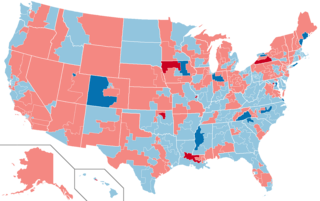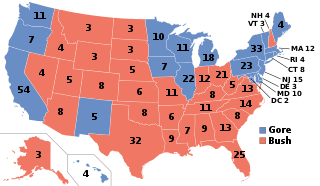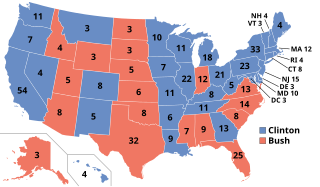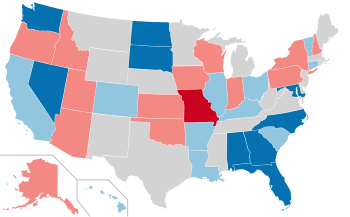The "Republican Revolution", "Revolution of '94", or "Gingrich Revolution" are political slogans that refer to the Republican Party (GOP) success in the 1994 U.S. mid-term elections, which resulted in a net gain of 54 seats in the House of Representatives, and a pick-up of eight seats in the Senate. On November 9, 1994, the day after the election, Senator Richard Shelby of Alabama, a conservative Democrat, changed parties, becoming a Republican; on March 3, 1995, Colorado Senator Ben Nighthorse Campbell switched to the Republican side as well, increasing the GOP Senate majority.

The 1986 United States Senate elections were elections for the United States Senate. Held on November 4, in the middle of Ronald Reagan's second presidential term, the 34 seats of Class 3 were contested in regular elections. The Republicans had to defend an unusually large number of freshman Senate incumbents who had been elected on President Ronald Reagan's coattails in 1980. Democrats won a net of eight seats, defeating seven freshman incumbents, picking up two Republican-held open seats, and regaining control of the Senate for the first time since January 1981. This remains the most recent midterm election in which the sitting president's party suffered net losses while still flipping a Senate seat.

The 1984 United States Senate elections were held on November 6, with the 33 seats of Class 2 contested in regular elections. They coincided with the landslide re-election of President Ronald Reagan in the presidential election. In spite of the lopsided presidential race, Reagan's Republican Party suffered a net loss of two Senate seats to the Democrats, although it retained control of the Senate with a reduced 53-47 majority. Democrats defeated incumbents in Illinois and Iowa, and won an open seat in Tennessee, while Republicans defeated an incumbent in Kentucky.

The 1986 United States House of Representatives elections was held on November 4, 1986, to elect U.S. Representatives to serve in the 100th United States Congress. They occurred in the middle of President Ronald Reagan's second term in office, while he was still relatively popular with the American public. As in most mid-term elections, the President's party — in this case, the Republican Party — lost seats, with the Democratic Party gaining a net of five seats and cementing its majority. These results were not as dramatic as those in the Senate, where the Republicans lost control of the chamber to the Democrats.

The 1980 United States House of Representatives elections was an election for the United States House of Representatives on November 4, 1980, to elect members to serve in the 97th United States Congress. They coincided with the election of Ronald Reagan as president, defeating Democratic incumbent Jimmy Carter. Reagan's victory also allowed many Republican House candidates to secure elections. The Republicans gained a net of 35 seats from the Democratic Party. The Democrats nonetheless retained a significant majority, unlike the Senate elections, where Republicans gained control of the chamber. However, many Democratic congressmen from the south frequently took conservative stances on issues, allowing Republicans to have a working ideological majority for some of President Reagan's proposals during his first two years in office.

The 1962 United States elections were held on November 6 to elect the members of the 88th United States Congress. The election occurred in the middle of Democratic President John F. Kennedy's term. The Republican Party picked up four seats in the House of Representatives. Still, the Democrats retained strong majorities in both houses of Congress.

The 2004 United States elections were held on Tuesday, November 2, 2004, during the early years of the war on terror and after the 2003 invasion of Iraq. Republican President George W. Bush won re-election and Republicans retained control of Congress.

The 1974 United States elections were held on November 5. The elections occurred in the wake of the Watergate scandal and three months into the term of Republican President Gerald Ford. Democrats expanded their majorities in both houses of Congress.

The 1980 United States elections were held on Tuesday, November 4. Republican presidential nominee Ronald Reagan defeated incumbent Democratic President Jimmy Carter in a landslide. Republicans picked up seats in both chambers of Congress and won control of the Senate, though Democrats retained a majority in the House of Representatives. The election is sometimes referred to as part of the "Reagan Revolution", a conservative realignment in U.S. politics and marked the start of the Reagan Era.

The 1982 United States elections were held on November 2, 1982. The elections occurred in the middle of Republican President Ronald Reagan's first term and after the 1980 United States census. Neither chamber of Congress changed hands.

The 2002 United States elections were held on November 5, in the middle of Republican President George W. Bush's first term. Republicans won unified control of Congress, picking up seats in both chambers of Congress, making Bush the first President since Franklin D. Roosevelt in 1934 to gain seats in both houses of Congress. In the gubernatorial elections, Democrats won a net gain of one seat. The elections were held just a little under fourteen months after the September 11 attacks. Thus, the elections were heavily overshadowed by the War on Terror, the impending Iraq War, the early 2000s recession, and the sudden death of Democratic Senator Paul Wellstone of Minnesota about one week before the election.

The 2000 United States elections were held on November 7, 2000. Republican Governor George W. Bush of Texas defeated Democratic Vice President Al Gore of Tennessee in the presidential election. Republicans retained control of both houses of Congress, giving the party unified control of Congress and the presidency for the first time since the 1954 elections.

The 1994 United States elections were held on November 8, 1994. The elections occurred in the middle of Democratic President Bill Clinton's first term in office, and elected the members of 104th United States Congress. The elections have been described as the "Republican Revolution" because the Republican Party captured unified control of Congress for the first time since 1952. Republicans picked up eight seats in the Senate and won a net of 54 seats in the House of Representatives. Republicans also picked up a net of ten governorships and took control of many state legislative chambers.

The 2012 United States elections took place on November 6, 2012. Democratic President Barack Obama won reelection to a second term and the Democrats gained seats in both chambers of Congress, retaining control of the Senate even though the Republican Party retained control of the House of Representatives. As of 2022, this is the most recent election cycle in which neither the presidency nor a chamber of Congress changed partisan control, and the last time that the winner of the presidential race provided coattails for their party in both the House of Representatives and the Senate.

The 1996 United States elections were held on November 5. Democratic President Bill Clinton won re-election, while the Republicans maintained their majorities in both houses of the United States Congress.

The 1992 United States elections elected state governors, the President of the United States, and members of the 103rd United States Congress. The election took place after the Soviet Union crumbled and the Cold War ended, as well as the redistricting that resulted from the 1990 Census. Governor Bill Clinton of Arkansas defeated incumbent President George H. W. Bush and businessman Ross Perot in the presidential election. The Democratic Party maintained their control of both chambers of Congress. This is the first Democratic trifecta since the Republican victory in the 1980 elections and the last one during the 20th century and the last one overall until 2008.

The 1984 United States elections was held on November 6, and elected the members of the 99th United States Congress. Republicans won a landslide victory in the presidential election, picked up seats in the House of Representatives, and successfully defended their Senate majority.

The 1988 United States elections were held on November 8 and elected the President of the United States and members of the 101st United States Congress. Republican Vice President George H. W. Bush defeated Democratic Governor of Massachusetts Michael Dukakis. Despite Dukakis' defeat, the Democratic Party built on their majorities in Congress.

The 1978 United States elections were held on November 7, 1978, to elect the members of the 96th United States Congress. The election occurred in the middle of Democratic President Jimmy Carter's term. Democrats retained control of both houses of Congress.

The 1966 United States elections were held on November 8, 1966, and elected the members of the 90th United States Congress. The election was held in the middle of Democratic President Lyndon B. Johnson's second term, and during the Vietnam War. Johnson's Democrats lost forty-seven seats to the Republican Party in the House of Representatives. The Democrats also lost three seats in the U.S. Senate to the Republicans. Despite their losses, the Democrats retained control of both chambers of Congress. Republicans won a large victory in the gubernatorial elections, with a net gain of seven seats. This was the first election held after the passage of the Voting Rights Act of 1965, which led to a surge in African-American voter participation.





















